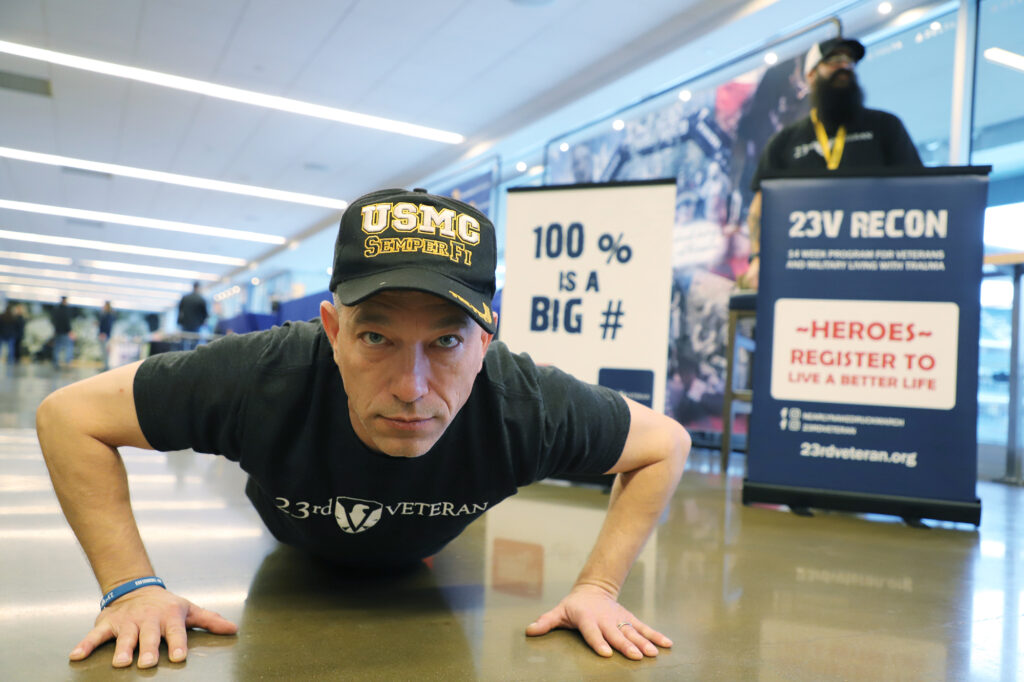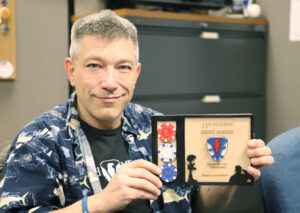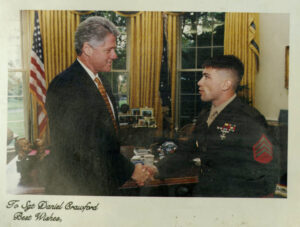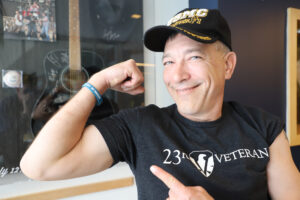
A better life
By Tim Engstrom
The Minnesota Legionnaire
BROOKLYN CENTER — The tale is as old as veterans in America. Veterans exit the military. They don’t stay connected with veterans. They lose a sense of purpose and that feeling of camaraderie. They struggle.
But when they return to the veterans community, their fellow veterans are there for them, to help them in their recovery.
Daniel Crawford, 53, has bounced back from alcoholism and life in limbo thanks to his involvement in Duluth-based 23rd Veteran and its peer-to-peer adventure and fitness program. He now has come to know The American Legion’s mission, and he is hopes the two find ways to work together.
For this Marine, it comes after years of post-military struggle.
Crawford was born in Fridley and moved to Kinney in 1976. He was a kid in the town when the Kinney City Council “seceded” from the Union in 1978 in an attempt to draw attention to federal, state and local bureaucratic red tape that prevented repairs to its crumbling water system. The humorous idea was to get foreign aid instead. The stunt made the “NBC Nightly News,” and, later that year, the city got its money, though not as foreign aid.
In eighth-grade, Crawford returned to the Twin Cities. He attended Centennial High School in Circle Pines.
He knew his future was not college, so he enlisted in the Army Reserves four days after his 17th birthday. He went to Fort Benning for basic between his junior and senior years. During his senior year, he decided to pursue active duty and seek technology training. He switched his enlistment to the Marines. He graduated in 1987 and entered the Marines in August.
It was back to boot camp, this time in San Diego. He went to communications electronics school at 29 Palms Marine Base but did not finish, as the Marines sent him into aircraft maintenance as a data analyst. His training was at the naval air station in Meridian, Miss.
Crawford worked with helicopters. He was stationed at Marine Corps Air Station New River, outside of Jacksonville, N.C., and just north of Camp Lejeune.
Yes, he spent times once in a while turning a wrench, but mainly what he did was logistics, troubleshooting and making sure tasks were accomplished properly.

He spent five years at MCAS New River and deployed three times: with the USS Iwo Jima amphibious assault ship on a six-month Mediterranean Sea cruise in 1989-90, for the Persian Gulf War on the USS Guam cruiser in 1990-91 and a second time with the Iwo Jima in 1991-92.
During the Gulf War, Crawford was part of a military evacuation of the U.S. embassy in the Somalian capital of Mogadishu.
The January 1991 emergency mission was called Operation Eastern Exit. It happened because of rising violence in December 1990, with militants surrounding the embassy after the collapse the Somalia government. U.S. Central Command opted to send 60 Marines on two CH-53E Super Stallion helicopters from the USS Guam to secure the embassy.
Four waves of five CH-46 Sea Knight choppers brought the U.S. personnel and families, including children, to the Guam, which brought them to Muscat, Oman. Later, they were flown to Germany, then to home.
Right after the war, Crawford married Anne Burch from Ham Lake.
In 1993, Crawford was promoted to sergeant and sent to HMX-1. That’s jargon for Marines Helicopter Squadron One, the Marines who transport the president, vice president, heads of state and other dignitaries around by helicopter. The mission is best known by the call sign “Marine One.”
Here, too, Crawford worked in logistics.
Seems like a fairly successful military career so far, huh?
Well, it wasn’t all rainbows and unicorns.
Two weeks prior to Crawford arriving at boot camp in San Diego, a Marine had been killed from brain trauma. At the end of boot camps, instructors would arrange informal boxing matches. The instructors had not checked the medical records for Pvt. Paul Resce Jr., which would have revealed prior head injuries. Nor did they consider that he was nearsighted and probably shouldn’t compete with so great of a disadvantage.
Crawford was 123 pounds going into boot camp. He realized one drill instructor took a special interest in him. The man would take him aside and smoke him. (Smoking means punishment by extra amounts of exercise.) He would remind Crawford of what happened to Pvt. Resce. Between the words and the smoking, Crawford knew this instructor wanted to have control over him.
One day, Crawford was cleaning the instructor’s office, which had a head and a rack for one. He was cleaning the shower stall when the instructor came in with nothing but a towel. He could tell the instructor wanted oral pleasure. Crawford played naïve and managed to refuse without provoking his ire. The instructor turned his attention on another recruit.
At the time, he was glad he no longer attracted the instructor’s attention, but with time, he felt guilty he didn’t stop the man from preying on the other recruit.
At 29 Palms, a fellow Marine died when the antenna on a PRC-77 radio hit a live power line, electrocuting him.
Crawford said there was no closure, no thoughtfulness, nothing.
“All we did was say, ‘OK, somebody’s gone.’”
In October 1989, while at the start of the first Iwo Jima deployment and just 80 miles southeast of Norfolk Naval Station in the Atlantic Ocean, Crawford was in his rack when he heard a loud bang over his head. Everyone wondered what was going on. The emergency response team went to the bridge.
Phalanx CIWS 20 mm projectiles from the USS El Paso, an amphibious cargo ship, struck the Iwo Jima. They killed navigator Lt. Cmdr. Timothy Kirtley and wounded Petty Officer 1st Class David Rawls. Both were standing on the bridge when struck.
The Phalanx rapid-fire gun automatically tracked and shot down a target drone in a live-fire exercise, but it then kept tracking and firing as the drone fell to the sea, and the gun mistakenly fired at the Iwo Jima’s starboard bridge wing and flight deck.
On the same cruise, in November 1989, two pilots, Michael Vidusek and Todd Travis, flew an AH-1T Cobra helicopter away from the Iwo Jima. Off the coast of Spain, it crashed, and the pilots died.
Crawford said not much was found. After both fatal incidents, everyone kept moving, ignoring the loss of life. There was no process.
“This is what messes us up,” he said.
1989 was a year full of fatal naval mishaps, and, that November, in an unprecedented move, the entire Navy stood down for two days to conduct a full review of safety and carelessness.
On his second Iwo Jima cruise, on Oct. 4, 1992, while in the Aegean Sea, Crawford witnessed a crewman on the flight deck walk into the tail rotor of a Cobra helicopter. It happened one hour after the captain had given a speech to the crew about the dangers of complacency.
Crawford was not aboard the Iwo Jima when its deadliest incident occurred. That happened in October 1990. Ten sailors were killed when a steam valve ruptured during exercises in the Arabian Sea.
Naval deployments, especially then, were more dangerous than members of the public may imagine today.
In 1993, Crawford came to Quantico Marine Base in northern Virginia. He had Top Secret and Yankee White security clearances. Getting a Yankee White takes a year because of its extensive background investigation.
“At that point, I thought going to HMX-1 would have been safe,” he said.
After all, Marine One is the only non-fail mission of the Marines. These are the cream of the crop, and Crawford worked in quality assurance.
But on May 19 of that year, four Marines died in a crash during an inspection flight of one of the VH-60N Black Hawk helicopters in the fleet. The crash was 10 miles east of Quantico.
Crawford filled out documentation for the military flight investigators.
“I gave them the paperwork for the aircraft and kept on going,” he said.

The TV show “Unsolved Mysteries” in 1997 even did an episode on it. That’s because the military blamed improperly installed roll pins, but the workers who built the chopper told the show it could not have flown in the first place with improperly installed roll pins. Also, a flight specialist concluded the true cause was flying into an area where the Army supposedly tested at-the-time-secretive microwave weapons.
Today, microwave weapons are no secret, but the case was closed decades ago.
Things weren’t peaches and cream before the military. A lot of people join the military to escape troubles at home, and Crawford was no different.
His parents divorced as a young child. His mother had an alcohol addiction. She remarried, giving young Daniel an alcoholic stepfather, too. Together, they often left him alone and, at times, abused. He said he also suffered sexual abuse as a child, but not from parents.
His actual father was not an alcoholic and, without custody, had moved away to Washington state. By eighth grade, Daniel pretty much was living alone, and that’s why he returned to Circle Pines. He would live with his grandmother.
“I’m not blaming the military for troubles in my life,” Crawford said. “Joining was me escaping real life by going into the military life.”
He got out of the Marines in December 1995 and returned to the Cities. He worked for family and friends, then got a job as a consultant as a systems administrator for a computer consulting firm. He exceled but was soon fired for “too much personality.”
Crawford said he was just a typical veteran among civilians. He began hitting the booze and struggling to figure out who he was in the civilian world.
“I’ve got all these computer skills, and I can’t land on my feet,” he said.
Finally, he got a job in St. Louis down in Missouri for Master Card as a systems administrator. He and Anne became parents. Their son, Joshua, was born in July 1997. (Today, Joshua is active-duty Air Force.)
By October, Crawford was in detox for alcohol. That failed. Then he went through chemical abuse treatment. Failed. He was prescribed an anti-depressant. More failure.
“I ended up leaving my wife and son, so I wouldn’t hurt them.”
Tears came to Crawford as he told the story.
“And I am sorry that I left them. Regardless of the problems we had, they didn’t deserve that.”
With a computer and $409, he purchased a Greyhound Ameripass and went all over the United States. His wife and son moved back to Minnesota.
“I searched out to find myself, and I didn’t do so well,” Crawford said.
The bus, after a month, brought him to Minneapolis, and eventually he found himself at Metro Hope Ministries. He credits its Christian-based, eight-month drug and alcohol recovery program for keeping him above ground.
“They are responsible, in my brain, for keeping my spiritually alive during that period,” he said. “It would have been easy for me to eat a bullet, but with that spiritual part, it kept the hope going.”
He said he also is grateful to his mother-in-law, Donna Burch, who continually prayed for him.
He tried to rekindle his marriage. However, he drank through the recovery program. He didn’t like sobriety.
“I wasn’t living. I wasn’t dying. I was in this limbo state,” Crawford said. “People are still walking on eggshells around me.”
He got a job doing computer consulting, and he would bill clients at a rate of $250 per hour. Not bad. He lived in Minneapolis with roommates and would fly to places like California and return home. He was high-functioning but miserable and drinking and not being much of a husband. Crawford went through the divorce.
One day in 2000, while at Minneapolis-St. Paul International Airport, Crawford talked to a lady who also was headed to California.
Months later, at the San Jose airport, she ran into him, and they exchanged numbers.
Amanda Burkart and Daniel Crawford became Amanda and Daniel Crawford in 2001, and they honeymooned in Florida. In fact, they were on the honeymoon when the 9/11 attacks happened.
They are still together today.

“We’ve had a marriage based on faith in each other, not love from me, because I didn’t know what that was from me. I was looking for it,” he said.
Amanda and Daniel had children: Abbie in 2005 and Amelia in 2006. Daniel still had a drinking problem but would stay sober to care for and to drive them. In 2008, son Patrick was born a premature baby.
Born four months early, he was 1.5 pounds. He spent 108 days at the neonatal intensive care unit at Children’s Hospital in Minneapolis, and came home at 5 pounds in April 2009.
In May 2009, Daniel’s mother died from alcoholism, giving him a clear picture of the grip alcohol can have on people.
He said he has been a good father but still lacked a sense of purpose and that feeling of camaraderie he had in the military. He isolated himself a lot.
By 2019, he had seen 50 states and still hadn’t found himself. He couldn’t hold a job, and he was living in Brooklyn Center. He still had an alcohol problem. He was a Brooklyn Center Post 260 member by this point, but he didn’t realize the Legion, or the VFW, for that matter, had purposes besides bars.
He worked for the Census Bureau doing recruitment, door knocking and various odd jobs.
That December, he worked at a Census Bureau table during the Minnesota Assistance Council for Veterans (MACV) Home for the Holidays event at Target Field.
“This was the first exposure to the veterans community,” he said.
That invigorated him with his Census job, and he made extra efforts to find veterans living in shelters or under bridges, to make sure they were counted.
On Facebook, he noticed MACV posted about 23rd Veteran, and its recon program. “Recon” stands for “reconditioning.” It is a 14-week peer-to-peer wellness adventure. He saw more about it later and decided to take a chance. He set a goal of remaining sober.
It wasn’t a substance abuse program, but being with other veterans worked. He stayed sober.
“If they had known how much I was into substance abuse at the time, they probably would not have accepted me,” Crawford said. “Now, I am their star graduate.”
The adventure starts out with a weeklong outdoor event, and in Crawford’s case, in April 2022, seven strangers were on a 30-foot boat off the coast of Florida. They got to know each other well and bonded. When they returned to the Twin Cities, they met three times a week while working out together at CrossFit Nordeast. He has a “playbook” that explains how to tap into brain chemicals for positivity, like how exercise leads to higher levels of dopamine.
“It’s given me the sense of purpose and camaraderie to deal with my problems in a safe manner,” he said. “I can be genuine — vulnerable.”
The 23rd Veteran program is known for its “Nearly Naked” ruck march fundraisers that also are food-raisers for veteran housing. The program exists in Duluth and the Twin Cities, and the 23rd Veteran team expanded the program to Philadelphia in November.
Crawford got to share his story at a ruck march kickoff in Valley Forge.
He thanked everyone who nudged him in the right direction.
The American Legion Department of Minnesota and 23rd Veteran had tables next to each other at MACV Home for the Holidays at Target Field last month. Also, Delano Post 377 donated to 23rd Veteran after one of its members went through the recon. And a ruck march might be coming to Delano in 2023.
Crawford has a clearer vision of The American Legion and the work it does for veterans, from legislative efforts to fundraising to being the largest veterans network in the world. That network is important for keeping veterans tuned in to the veterans community.
Now Crawford is a recon coordinator for 23rd Veteran, and he will be leading the next group. Part of the program is remembering to be grateful at least three times a day.
He is grateful for Amanda.
“She said this has been an amazing chase for you in many ways,” he said. “When you put your mind to something you are passionate about, you are unstoppable.”